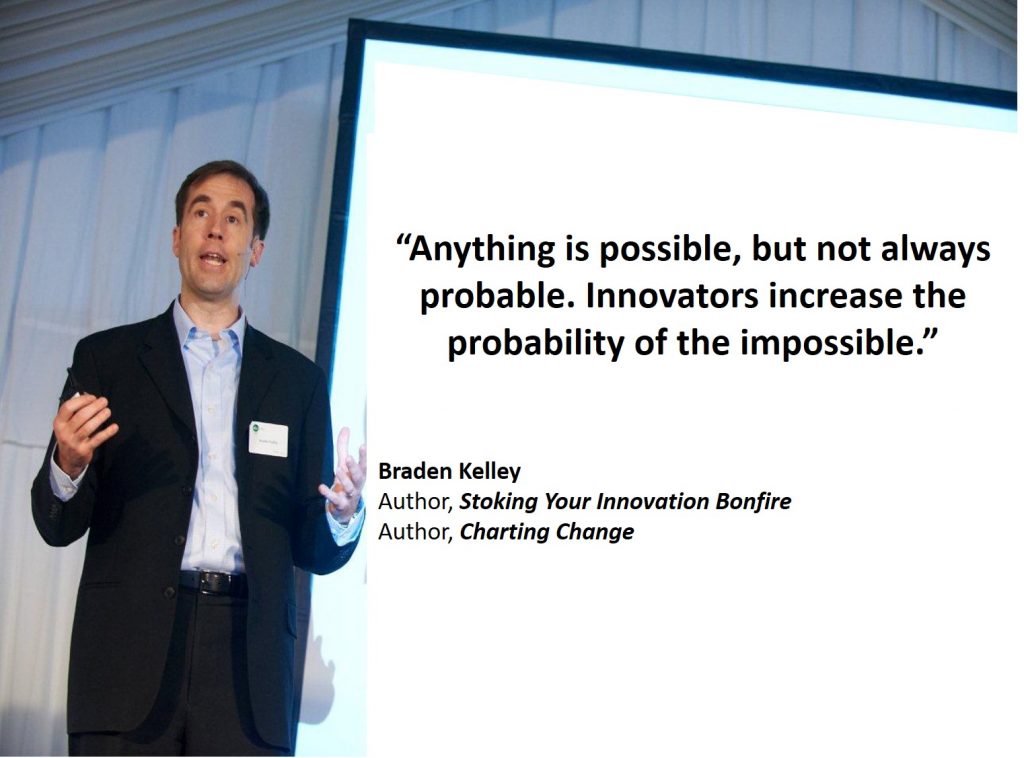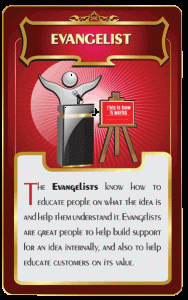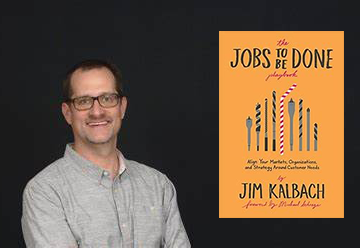
What is an evangelist?
When many people hear this term, their minds used to picture Billy Graham or Pat Robertson, but this is changing. Why?
Our perceptions of evangelists are transforming as the pace of change accelerates to construct a new reality faster than most human brains can process the changes.
This creates a chasm in understanding and change readiness that evangelists can help bridge in a number of different ways.
Let us look at what an evangelist really is…
Oxford Dictionaries say an evangelist is a “zealous advocate of something.”
 In business, the evangelist is a role that any of us can take on (with varying levels of success). Evangelism is very important to innovation success, which is why the evangelist is one of The Nine Innovation Roles™. This is how I define this particular role:
In business, the evangelist is a role that any of us can take on (with varying levels of success). Evangelism is very important to innovation success, which is why the evangelist is one of The Nine Innovation Roles™. This is how I define this particular role:
“The Evangelists know how to educate people on what the idea is and help them understand it. Evangelists are great people to help build support for an idea internally, and also to help educate customers on its value.”
Notice at this point we are talking about an evangelist as a role that can be played by one or more people, and not as a job that one or more people hold. Evangelism normally will be a role and not a job, but there are inflection points where this must change.
Outside of an innovation context, evangelism often falls on the shoulders of CEOs, business owners and product managers within organizations. When the need for evangelism is small, this can work. But for most organizations, this is no longer the case.
When should you hire an evangelist?
The time to cross over from evangelism as a role to evangelism as a job is when:
- The pace of internal change is accelerating faster than employees can grasp without help
- The pace of external change is accelerating faster than customers can understand without help
- Your company is facing disruption by new entrants or existing competitors
- You’re considering a digital transformation
- You’ve already embarked upon a digital transformation
- You’re using Agile in product development
- Your brand essence is being shifted by you or your customers
- You need a more human and personal presence in your marketing efforts to better connect with customers
When one or more of these conditions are true, you’ll find that it isn’t possible for CEOs, business owners and product owners to meet the needs for evangelism in the short spurts of time these people can dedicate to the necessary activities.
As highlighted by Agile Product Development’s presence in the list, organizations leveraging Agile to develop software-based products will find that their product managers are always engaged with the backlog with little time to focus on evangelism. They’re always focused on shipping something.
Some organizations will resist adding evangelists to their team, feeling that such a role is superfluous, but having one or more people focused on evangelism delivers value to the organization by executing a range of incredibly important activities, including:
- Growing awareness
- Building a community around the company and/or plugging the company into pre-existing external communities (potentially taking the brand to places it has never been before)
- Generating interest
- Working with customers and the marketing team to identify the stories that need to be told and the themes that need to be introduced and/or reinforced
- Creating desire
- Building and maintaining conversations with the community that cares about your products/services/brands
- Engaging in an open and honest dialogue to help gather the voice of the customer
- Facilitating action
- Practicing a human-centered design mindset to continuously elicit needs and surface wants and desired outcomes
Depending on the size of the organization you may decide to have a single evangelist, or some larger organizations have more than one type of evangelist, including:
- Chief Evangelist
- Brand Evangelists
- Product Evangelists
- Service Evangelists
- Innovation Evangelists
This specialization occurs when the evangelism an organization needs become too big for one evangelist to handle. At that point a Chief Evangelist creates the evangelism strategy and manages the execution across the team of brand, product, service and other evangelism focus areas.
So what makes a good evangelist?
Evangelists arrive from a range of different job specialties, but key knowledge, skills and abilities include:
- Empathetic
- Passionate About the Company’s Mission, Products/Services, and Customers
- Comfortable Public Speaker
- Efficient and Effective Writer
- Human-Centered Design Mindset
- Experienced with Social Media, Audio and Video
- Skilled Content Creator
- Continuous Learner
- Self-Directed and Comfortable with Ambiguity
… and ideally your chosen evangelists will already have some presence in the communities important to you, or the knowledge of how to establish a presence in these communities.
Customer buying journeys are notoriously unpredictable, meandering, long and non-linear. Evangelism is a critical part of helping to build relationships with potential buyers and increasing the chances that your brand will be top of mind when a non-buyer finally becomes a potential customer of your products or services.
It’s a long-term non-transactional investment, one that will pay dividends if you see the wisdom in making the expenditure.
Has your organization already invested in evangelists? What learnings would you like to share in the comments?
Are you ready for the evangelists to rise in your organization?
Or do you need help with evangelism? (contact me if you do)
Share the love!
p.s. I wrote a follow-up article for InnovationManagement.se that you might also enjoy — Increase Your Innovation Reputation and Velocity with an Innovation Evangelist

![]() Sign up here to get Human-Centered Change & Innovation Weekly delivered to your inbox every week.
Sign up here to get Human-Centered Change & Innovation Weekly delivered to your inbox every week.
 The Jobs-to-be-Done (JTBD) approach offers a unique lens for viewing the people you serve. Instead of looking at the demographic and psychographic factors of consumption, JTBD focuses on what people seek to achieve in a given circumstance. People don’t “hire” products and services because of the demographic they belong to; instead, they employ solutions to get a job done.
The Jobs-to-be-Done (JTBD) approach offers a unique lens for viewing the people you serve. Instead of looking at the demographic and psychographic factors of consumption, JTBD focuses on what people seek to achieve in a given circumstance. People don’t “hire” products and services because of the demographic they belong to; instead, they employ solutions to get a job done.